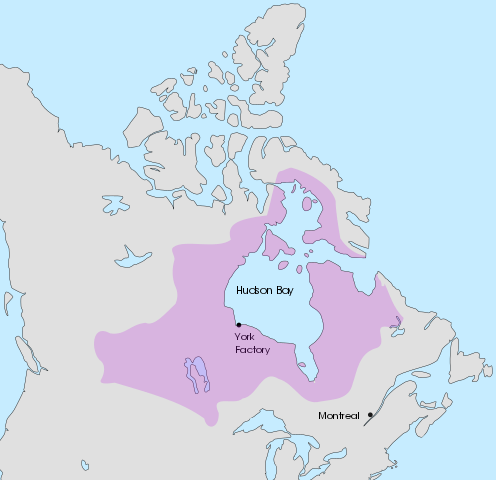As a kid growing up in the late 60s and early 70s, “The Bay” was just a department store. It wasn’t as upscale as Eaton’s, but had different stock than Eaton’s or Simpson’s so occasionally you’d find something there that wasn’t available in the other major central Canadian department stores. It took me an embarrassingly long time to make the connection between the big retail store in the mall and the company that owned vast swathes of what eventually became Canada in the seventeenth and eighteenth centuries. At Terra Nullius, Ned Donovan tries to put that massive geo-political organization into context:
At the turn of the 17th Century, felt hats were all the rage and felt hats are made of beaver skin. At the time, this relied on Russia’s long-established fur trade. But as demand grew, quality dropped significantly as the native European beaver population began to be hunted out of existence. Within decades, it was very difficult for merchants to find high quality felt from Russia, and customers in England were complaining that they were having to wear felt made from rabbit instead.
Approximate extent of Prince Rupert’s Land in the late 17th to early 18th century – note that this is the range of the company’s trappers and traders, not military or political control.
Image from Wikimedia Commons.But around the same time, irregular and rare shipments began to arrive from the European colonies in North America where beaver – mostly trapped by French settlers and Indigenous Americans – was still plentiful and of very good quality. In 1669, the ship Nonsuch dropped anchor in the Thames with a large shipment of some of the highest quality furs London had ever seen, selling them immediately for £1,233 (equivalent to around £1 million in 2022). The Nonsuch had led an expedition invested in by some of London’s richest merchants and sponsored by Prince Rupert, a first cousin of King Charles II. It had done its trapping in Hudson’s Bay in the north of what is now Canada. The purpose of the expedition was to demonstrate that the issues with fur supply could be solved if its trapping in North America could be optimised, leaving behind the slow and traditional approach of the French and First Nation trappers.
This was not the first time Prince Rupert had seen to make money from exploiting colonised lands, having poured large amounts of his wealth into the slave trade from West Africa and sitting on the board of the Royal African Company. With this financial success made from trading in human lives, he turned his interest to North America and helped put together the syndicate that sent the Nonsuch to Hudson’s Bay. In 1670, his cousin King Charles II granted the syndicate a royal charter to form the Hudson’s Bay Company, giving the company a monopoly over “Prince Rupert’s Land” made up of the land drained by rivers and streams flowing into Hudson’s Bay – or 3,861,400 square kilometres.
In short order, the company had established trading posts throughout its monopoly, known as factories (as each was controlled by a company official known as a factor). The only thing that mattered to these factories and its parent company was beaver. Nothing could stand in the way of ensuring the safe passage of furs and pelts to Europe. By 1690, the demand in England for hats and caps was five million per year – or one per person. Hundreds of thousands more would be exported onwards from England to Europe such was the demand for the well-known quality of the Hudson Bay beaver. For example in 1756, Portuguese customers spent more than £20 million in today’s money on English beaver felt hats.
As Prince Rupert’s Land was largely still wilderness, besides company staff it was inhabited only by European and First Nations trappers and as a result there was only a barter economy, to both subjugate indigenous residents and prevent private wealth. There were standardised prices throughout Prince Rupert’s Land and instead of a normal currency, the company instead pegged everything against the unit of 1MB (1 Made Beaver). For three made beaver pelts, you could be given one clay pot in exchange at a company store, or for 10 you could get a gun. Private trading was outlawed and all beaver pelts that left Prince Rupert’s Land traveled through the warehouses and accounts of the Hudson’s Bay Company.




